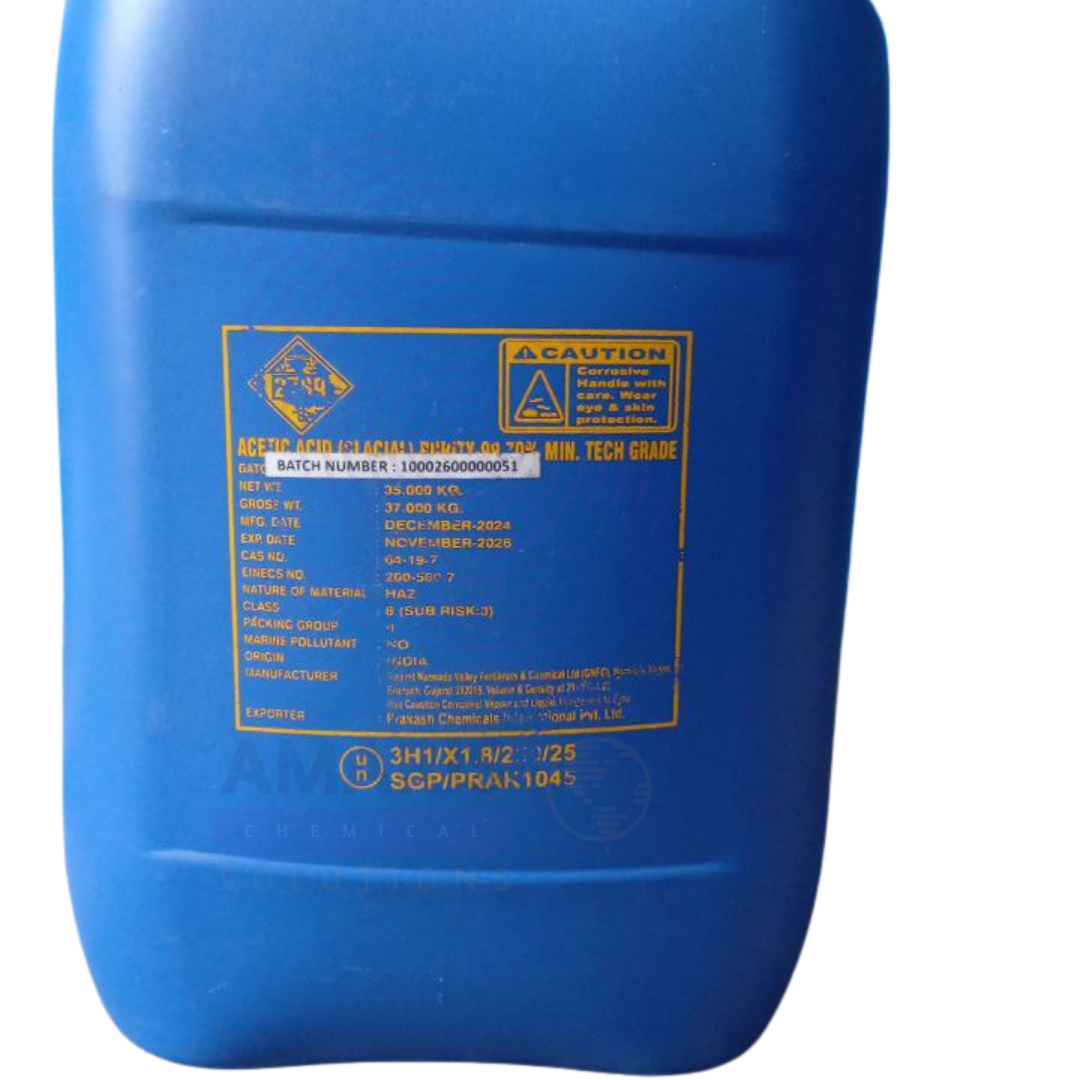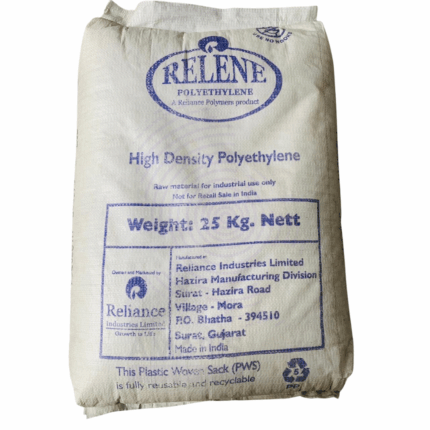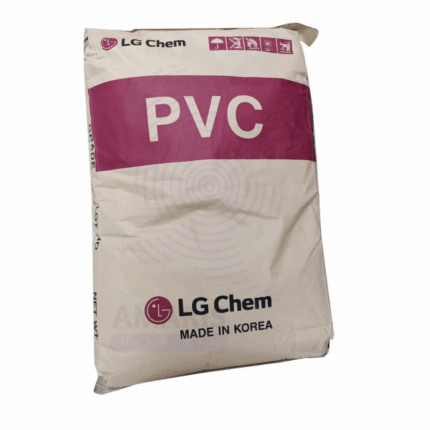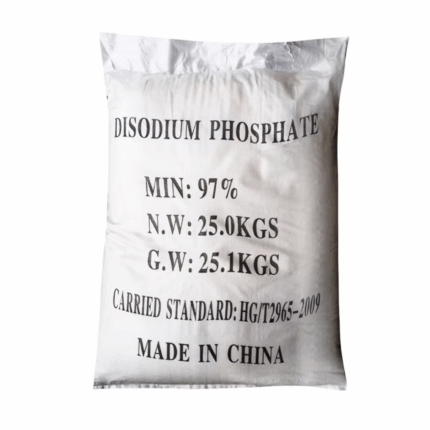
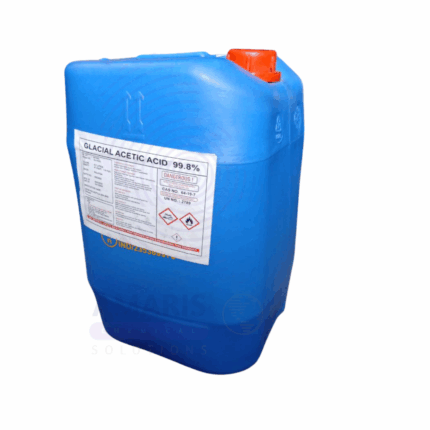
Glacial Acetic Acid Tech grade
$ 2.25 Original price was: $ 2.25.$ 2.16Current price is: $ 2.16.
Glacial Acetic Acid Tech grade is a clear, colorless liquid with a pungent vinegar-like odor. It is a less refined form of acetic acid primarily used for industrial and technical applications rather than food or pharmaceutical uses. Typically available in concentrations ranging from 80% to glacial (99-100%), it serves as a crucial chemical reagent, solvent, and intermediate in various industrial processes.
Glacial Acetic Acid Tech grade
Primary Uses
- Chemical Manufacturing and Industrial Synthesis
- Intermediate in chemical production: Used to synthesize esters (e.g., ethyl acetate, butyl acetate), acetic anhydride, vinyl acetate monomer (VAM), and acetamide.
- Plastic and polymer industry: Employed in the production of cellulose acetate (used in photographic films, coatings, and plastics).
- Rubber processing: Acts as a coagulant in natural rubber latex processing.
- Dye and pigment production: Utilized as a reagent or solvent in the synthesis of dyes, pigments, and ink components.
- Textile Industry
- Dyeing and finishing agent: Used to adjust pH during dyeing processes and enhance dye uptake and fixation on fabrics.
- Scouring and desizing agent: Helps remove starch and other sizing agents from yarns and fabrics before dyeing.
- Cleaning textile equipment: Acts as a descaling and cleaning agent in textile machinery.
- Leather and Tanning Industry
- pH control in tanning: Used in pickling and tanning steps to maintain appropriate acidity levels.
- Softening and fatliquoring processes: Improves the flexibility and texture of hides during processing.
- Agricultural and Veterinary Use
- Silage preservative: Used in diluted form to inhibit mold and microbial spoilage during fodder fermentation.
- pH regulator in pesticides and herbicides: Adjusts formulation pH for better stability and efficacy.
- Natural herbicide component: Included in organic weed control solutions due to its ability to burn plant tissue.
- Antimicrobial for animal housing: Used in disinfectant solutions for cleaning animal pens and tools.
- Cleaning and Maintenance Applications
- Industrial descaler: Removes limescale and mineral deposits from machinery, pipelines, and boilers.
- Degreasing agent: Helps in removing oil and greasy residues from metal surfaces during pre-treatment processes.
- Sanitizing agent in breweries and dairies: Used for cleaning fermentation vessels, tubing, and equipment (non-food contact surfaces only).
- Paints, Coatings, and Adhesives
- Solvent carrier: Functions as a solvent for paints, adhesives, varnishes, and sealants.
- pH control in formulations: Used in coatings and resins to manage acidity during processing.
Secondary Uses
- Water Treatment
- pH adjustment: Occasionally used to control alkalinity and scaling in industrial water treatment systems.
- Electronics Industry
- Etching agent: Involved in the preparation of metal surfaces for microelectronic component fabrication.
- Laboratory and Analytical Applications
- Reagent in titrations and synthesis: Used in various chemical reactions and buffer preparations.
- Solvent medium: Occasionally used to dissolve inorganic salts or act as a medium for specific organic reactions.
- Construction and Surface Preparation
- Concrete cleaning: Removes efflorescence, mineral buildup, and rust stains on masonry and concrete surfaces.
- Surface pH control: Prepares concrete or masonry before coating or sealing
1. Basic Identification Attributes
- Chemical Name (IUPAC): Ethanoic acid
- Common/Trade Names:
- Technical-grade acetic acid
- Glacial acetic acid (if ≥99% purity)
- CAS Number: 64-19-7
- HS Code: 2915.21.00 (varies by country)
- Molecular Formula: C₂H₄O₂ (CH₃COOH)
- Synonyms:
- Methanecarboxylic acid
- Ethylic acid
2. Physical & Chemical Properties
- Physical State: Clear, colorless liquid (glacial form solidifies below 16.6°C)
- Color & Odor: Pungent vinegar-like odor; may appear slightly yellow if impure
- Melting Point: 16.6°C (61.9°F)
- Boiling Point: 118.1°C (244.6°F)
- Density: 1.049 g/cm³ (25°C)
- Solubility:
- Miscible in water, ethanol, ether
- pH Level: Strongly acidic (~2.4 at 1.0 M)
- Vapor Pressure: 15.7 mmHg (25°C)
- Flash Point: 39°C (102°F) (closed cup)
- Autoignition Temperature: 427°C (801°F)
- Viscosity: 1.22 mPa·s (25°C)
3. Safety & Hazard Attributes
- Hazard Class (GHS):
- Corrosive (Category 1B)
- Flammable (Category 3, for concentrations >80%)
- Skin/Eye Irritant (Category 1)
- NFPA Ratings:
- Health: 3 | Flammability: 2 | Reactivity: 0
- Exposure Limits:
- OSHA PEL: 10 ppm (25 mg/m³)
- ACGIH TLV: 10 ppm (25 mg/m³)
- Reactivity:
- Corrosive to metals (releases H₂ gas)
- Reacts violently with oxidizers (e.g., chromic acid, permanganates)
4. Storage & Handling Attributes
- Storage Conditions:
- Store in a cool, ventilated area (<25°C)
- Keep away from oxidizers and bases
- Use corrosion-resistant containers (HDPE, stainless steel 316)
- Incompatible Materials:
- Strong bases (e.g., NaOH), nitric acid, peroxides
- Container Type:
- HDPE drums or stainless steel tanks
- Avoid aluminum and copper
- Shelf Life: Indefinite if sealed (but may absorb moisture)
- Special Handling:
- Use nitrile gloves, goggles, and fume hood
- Ground containers to prevent static sparks
5. Regulatory & Compliance Attributes
- Regulatory Status:
- EPA: Listed as a hazardous substance (CERCLA)
- REACH: Registered
- DOT: UN 2789 (Class 8 – Corrosive)
- Hazard Symbols (GHS):
- Corrosion
- Flame (for concentrations >80%)
- Transportation Restrictions:
- UN Number: 2789
- Packing Group: II
- Waste Disposal:
- Neutralize with sodium bicarbonate before disposal
- EPA Hazardous Waste Code: D002 (corrosive)
6. Environmental & Health Impact
- Ecotoxicity:
- LC50 (fish): ~50–100 mg/L
- Readily biodegradable
- Persistence: Breaks down in air/water within days
- Carcinogenicity: Not classified (IARC/NTP)
- Biodegradability: >90% in 28 days (OECD 301B)
Safety Precautions
Personal Protective Equipment (PPE)
- Gloves: Chemical-resistant (neoprene, nitrile, or PVC).
- Eye/Face Protection: Goggles + face shield (mandatory for concentrated acetic acid).
- Respiratory Protection: NIOSH-approved respirator (organic vapor cartridge) if ventilation is inadequate.
- Body Protection: Chemical-resistant apron or suit (for large spills/high concentrations).
Handling & Storage
- Ventilation: Use in a fume hood or well-ventilated area.
- Static Electricity Prevention: Ground and bond containers to avoid sparks.
- Incompatible Materials: Keep away from:
- Oxidizers (e.g., nitric acid, hydrogen peroxide) → violent reactions.
- Bases (e.g., sodium hydroxide) → exothermic neutralization.
- Metals (e.g., aluminum, zinc) → corrosion & hydrogen gas release.
- Storage:
- Sealed, corrosion-resistant containers (HDPE, stainless steel, or glass-lined tanks).
- Cool, dry, well-ventilated area away from sunlight and heat sources.
- Flammable storage cabinet (if ≥80% concentration).
Hygiene Measures
- No eating, drinking, or smoking in handling areas.
- Emergency shower & eyewash station must be accessible.
- Wash hands thoroughly after handling.
First Aid Measures
Inhalation (Vapors/Fumes)
- Move to fresh air immediately.
- If breathing is difficult, administer oxygen and seek medical help.
- If unconscious, perform CPR (if trained) and call emergency services.
Skin Contact
- Remove contaminated clothing immediately.
- Rinse with plenty of water for ≥15 minutes.
- Apply soap to remove residual acid.
- Seek medical attention if burns or irritation persist.
Eye Contact
- Immediately flush eyes with water for ≥15 minutes (hold eyelids open).
- Do NOT rub eyes.
- Seek emergency medical care (risk of corneal damage).
Ingestion
- Do NOT induce vomiting (risk of esophageal burns).
- Rinse mouth with water.
- Drink milk or water to dilute (if conscious).
- Seek immediate medical attention.
Firefighting Measures
Fire Hazards
- Highly flammable (≥80% concentration, flash point 39°C / 102°F).
- Vapors can form explosive mixtures with air.
- Decomposes at high temps, releasing flammable gases (CO, CO₂).
Extinguishing Media
✔ Alcohol-resistant foam
✔ CO₂
✔ Dry chemical powder
✔ Water spray (to cool containers, not direct jet—may spread flames).
Firefighting Precautions
- Wear SCBA (self-contained breathing apparatus) and full protective gear.
- Evacuate area—vapors travel and can ignite.
- Cool nearby containers with water spray to prevent explosion.
- Do NOT extinguish flames unless leak is stopped (risk of re-ignition).
Spill & Leak Control
- Small Spills:
- Neutralize with sodium bicarbonate (baking soda) or calcium carbonate.
- Absorb with inert material (vermiculite, sand).
- Dispose as hazardous waste.
- Large Spills:
- Evacuate area.
- Use acid-resistant PPE.
- Contain spill with barriers (clay, sandbags).
- Ventilate area to disperse vapors.


 Preservatives(food)
Preservatives(food) Flavor Enhancers
Flavor Enhancers Acidulants
Acidulants Sweeteners
Sweeteners Antioxidants
Antioxidants Colorants(food)
Colorants(food) Nutraceutical Ingredients (food)
Nutraceutical Ingredients (food) Nutrient Supplements
Nutrient Supplements Emulsifiers
Emulsifiers
 Collectors
Collectors Dust Suppressants
Dust Suppressants Explosives and Blasting Agents
Explosives and Blasting Agents Flocculants and Coagulants
Flocculants and Coagulants Frothers
Frothers Leaching Agents
Leaching Agents pH Modifiers
pH Modifiers Precious Metal Extraction Agents
Precious Metal Extraction Agents
 Antioxidants(plastic)
Antioxidants(plastic) Colorants (Pigments, Dyes)
Colorants (Pigments, Dyes) Fillers and Reinforcements
Fillers and Reinforcements Flame Retardants
Flame Retardants Monomers
Monomers Plasticizers
Plasticizers Polymerization Initiators
Polymerization Initiators Stabilizers (UV, Heat)
Stabilizers (UV, Heat)
 Antifoaming Agents
Antifoaming Agents Chelating Agents
Chelating Agents Coagulants and Flocculants
Coagulants and Flocculants Corrosion Inhibitors
Corrosion Inhibitors Disinfectants and Biocides
Disinfectants and Biocides Oxidizing Agents
Oxidizing Agents pH Adjusters
pH Adjusters Scale Inhibitors( water)
Scale Inhibitors( water)
 Antioxidants(cosmetic)
Antioxidants(cosmetic) Emollients
Emollients Fragrances and Essential Oils
Fragrances and Essential Oils Humectants
Humectants Preservatives
Preservatives Surfactants(cosmetic)
Surfactants(cosmetic) Thickeners
Thickeners UV Filters
UV Filters
 Fertilizers
Fertilizers Soil Conditioners
Soil Conditioners Plant Growth Regulators
Plant Growth Regulators Animal Feed Additives
Animal Feed Additives Biostimulants
Biostimulants Pesticides (Herbicides, Insecticides, Fungicides)
Pesticides (Herbicides, Insecticides, Fungicides)
 Active Pharmaceutical Ingredients (APIs)
Active Pharmaceutical Ingredients (APIs) Excipients
Excipients Solvents(pharmaceutical)
Solvents(pharmaceutical) Antibiotics
Antibiotics Antiseptics and Disinfectants
Antiseptics and Disinfectants Vaccine Adjuvants
Vaccine Adjuvants Nutraceutical Ingredients (pharmaceutical)
Nutraceutical Ingredients (pharmaceutical) Analgesics & Antipyretics
Analgesics & Antipyretics
 Analytical Reagents
Analytical Reagents Solvents(lab)
Solvents(lab) Chromatography Chemicals
Chromatography Chemicals Spectroscopy Reagents
Spectroscopy Reagents microbiology-and-cell-culture-reagents
microbiology-and-cell-culture-reagents Molecular Biology Reagents
Molecular Biology Reagents Biochemical Reagents
Biochemical Reagents Inorganic and Organic Standards
Inorganic and Organic Standards Laboratory Safety Chemicals
Laboratory Safety Chemicals Specialty Laboratory Chemicals(Special Laboratory Equipment)
Specialty Laboratory Chemicals(Special Laboratory Equipment)
 Demulsifiers
Demulsifiers Hydraulic Fracturing Fluids
Hydraulic Fracturing Fluids Scale Inhibitors(oil)
Scale Inhibitors(oil) Surfactants(oil)
Surfactants(oil) Drilling Fluids
Drilling Fluids
 Dyes and Pigments
Dyes and Pigments Bleaching Agents
Bleaching Agents Softening Agents
Softening Agents Finishing Agents
Finishing Agents Antistatic Agents
Antistatic Agents
 Admixtures
Admixtures Waterproofing Agents
Waterproofing Agents Sealants and Adhesives
Sealants and Adhesives Curing Compounds
Curing Compounds Concrete Repair Chemicals
Concrete Repair Chemicals Anti-Corrosion Coatings
Anti-Corrosion Coatings
 Surfactants(cleaning)
Surfactants(cleaning) Builders
Builders Enzymes
Enzymes Solvents (Cleaning)
Solvents (Cleaning) Fragrances
Fragrances
 Electronic Chemicals
Electronic Chemicals Catalysts
Catalysts Lubricants
Lubricants Photographic Chemicals
Photographic Chemicals Refrigerants
Refrigerants Automotive chemicals
Automotive chemicals Pyrotechnic Chemicals
Pyrotechnic Chemicals
 Biodegradable Surfactants
Biodegradable Surfactants Bio-based Solvents
Bio-based Solvents Renewable Polymers
Renewable Polymers Carbon Capture Chemicals
Carbon Capture Chemicals Wastewater Treatment Chemicals
Wastewater Treatment Chemicals
 Pigments
Pigments Solvents(paint)
Solvents(paint) Specialty Coatings
Specialty Coatings Binders/Resins
Binders/Resins Additives
Additives Driers
Driers Anti-Corrosion Agents
Anti-Corrosion Agents Functional Coatings
Functional Coatings Application-Specific Coatings
Application-Specific Coatings
 Fresh Herbs
Fresh Herbs Ground Spices
Ground Spices Whole Spices
Whole Spices Spice Blends
Spice Blends Dried Herbs
Dried Herbs
 Leavening Agents
Leavening Agents Dough Conditioners
Dough Conditioners Flour Treatments
Flour Treatments Fat Replacers
Fat Replacers Decoratives
Decoratives Preservatives(baking)
Preservatives(baking)
 Plasticizers & Softeners
Plasticizers & Softeners Reinforcing Agents
Reinforcing Agents Adhesion Promoters
Adhesion Promoters Vulcanizing Agents
Vulcanizing Agents Antidegradants
Antidegradants Blowing Agents
Blowing Agents Fillers & Extenders
Fillers & Extenders Accelerators & Retarders
Accelerators & Retarders